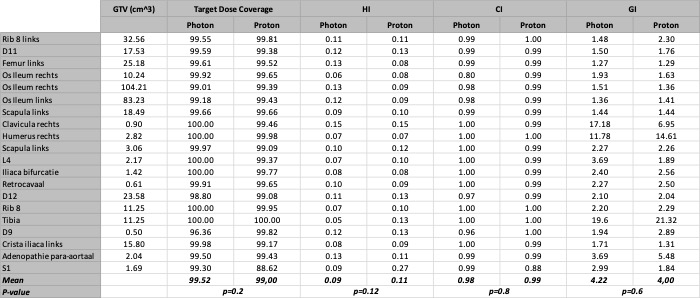Protons versus photons for oligometastatic prostate cancer: a planning comparison
PO-1495
Abstract
Protons versus photons for oligometastatic prostate cancer: a planning comparison
Authors: Kato Rans1, Gert De Meerleer1, Charlien Berghen1, Kenneth Poels1
1University Hospitals Leuven, Radiation Oncology, Leuven, Belgium
Show Affiliations
Hide Affiliations
Purpose or Objective
To investigate whether stereotactic body radiation therapy (SBRT) or stereotactic body proton therapy (SBPT) is the preferred modality for metastasis-directed therapy in patients with oligometastatic prostate cancer (PCa).
Material and Methods
12 patients with 25 metastatic lesions that previously were treated with photon SBRT for oligometastatic castration refractory PCa in the non-randomized phase 2 Medcare trial (NCT04222634) were replanned with photons and protons with Raystation 11A (Raysearch Laboraties). The gross target volume (GTV) and delineation of the critical organs at risk (OAR) were maintained from the previous SBRT plan. The planning was performed with the objective of attaining a NID2 of at least 110 Gy. The prescribed dose was 36 Gy (relative biological effectiveness (RBE)) in 3 fractions of 12 Gy prescribed to the GTV. The best photon plan was compared with the best proton plan if 99 % of the GTV received 99 % of the prescribed dose in the photon or proton plan. Pairwise dosimetric comparisons of the treatment plans were performed for the OARs, homogeneity index (HI), conformity index (CI) and gradient index (GI). A 2-sided Wilcoxon signed-rank test with significance level of 5% was carried out.
Results
The target dose coverage was reached in 18/25 (72 %) of the photon plans and in 19/25 (76 %) of the proton plans. In total 20 lesions received our proposed target dose coverage in one of the 2 modalities and 17 lesions in both modalities. There was no significance difference for target dose coverage (p = 0.2), homogeneity index (p = 0.12), conformity index (p = 0.8) and gradient index (p = 0.6) between the SBRT and SBPT plans. Improved sparing of the OARs was made possible with the SBPT plans. There was a significant decrease of the mean dose delivered to the right and left lung (p = 0.012). The maximum doses on the spinal cord (p = 0.007), great vessels (p = 0.02), colon (p = 0.01), esophagus (p = 0.008) and jejunum/ileum (p = 0.006) were significantly lower with SBPT than with SBRT. The maximum dose on the skin was significantly higher with SBPT than with SBRT (p = 0.03). There was no significance difference for the sacral plexus (p = 0.069).


Conclusion
The proton based stereotactic body plans provided a similar target dose coverage with no difference in homogeneity, conformity, or gradient index. So, in the setting of metastasis-directed therapy for patient with oligometastatic prostate cancer SBPT is feasible and can significantly reduce the dose on the OARs, in comparison to SBRT.